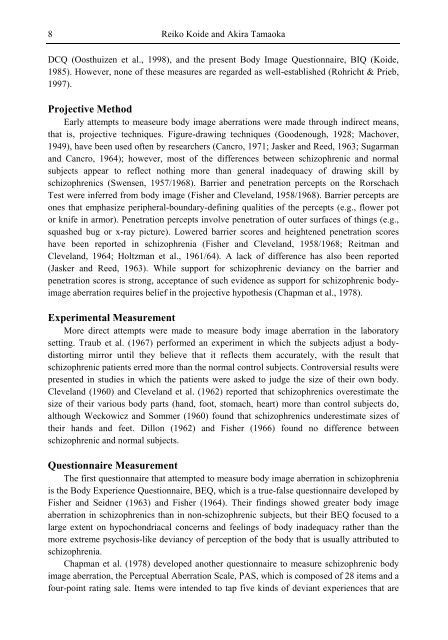Schizophrenia Research Trends
Schizophrenia Research Trends
Schizophrenia Research Trends
- No tags were found...
You also want an ePaper? Increase the reach of your titles
YUMPU automatically turns print PDFs into web optimized ePapers that Google loves.
8Reiko Koide and Akira TamaokaDCQ (Oosthuizen et al., 1998), and the present Body Image Questionnaire, BIQ (Koide,1985). However, none of these measures are regarded as well-established (Rohricht & Prieb,1997).Projective MethodEarly attempts to measeure body image aberrations were made through indirect means,that is, projective techniques. Figure-drawing techniques (Goodenough, 1928; Machover,1949), have been used often by researchers (Cancro, 1971; Jasker and Reed, 1963; Sugarmanand Cancro, 1964); however, most of the differences between schizophrenic and normalsubjects appear to reflect nothing more than general inadequacy of drawing skill byschizophrenics (Swensen, 1957/1968). Barrier and penetration percepts on the RorschachTest were inferred from body image (Fisher and Cleveland, 1958/1968). Barrier percepts areones that emphasize peripheral-boundary-defining qualities of the percepts (e.g., flower potor knife in armor). Penetration percepts involve penetration of outer surfaces of things (e.g.,squashed bug or x-ray picture). Lowered barrier scores and heightened penetration scoreshave been reported in schizophrenia (Fisher and Cleveland, 1958/1968; Reitman andCleveland, 1964; Holtzman et al., 1961/64). A lack of difference has also been reported(Jasker and Reed, 1963). While support for schizophrenic deviancy on the barrier andpenetration scores is strong, acceptance of such evidence as support for schizophrenic bodyimageaberration requires belief in the projective hypothesis (Chapman et al., 1978).Experimental MeasurementMore direct attempts were made to measure body image aberration in the laboratorysetting. Traub et al. (1967) performed an experiment in which the subjects adjust a bodydistortingmirror until they believe that it reflects them accurately, with the result thatschizophrenic patients erred more than the normal control subjects. Controversial results werepresented in studies in which the patients were asked to judge the size of their own body.Cleveland (1960) and Cleveland et al. (1962) reported that schizophrenics overestimate thesize of their various body parts (hand, foot, stomach, heart) more than control subjects do,although Weckowicz and Sommer (1960) found that schizophrenics underestimate sizes oftheir hands and feet. Dillon (1962) and Fisher (1966) found no difference betweenschizophrenic and normal subjects.Questionnaire MeasurementThe first questionnaire that attempted to measure body image aberration in schizophreniais the Body Experience Questionnaire, BEQ, which is a true-false questionnaire developed byFisher and Seidner (1963) and Fisher (1964). Their findings showed greater body imageaberration in schizophrenics than in non-schizophrenic subjects, but their BEQ focused to alarge extent on hypochondriacal concerns and feelings of body inadequacy rather than themore extreme psychosis-like deviancy of perception of the body that is usually attributed toschizophrenia.Chapman et al. (1978) developed another questionnaire to measure schizophrenic bodyimage aberration, the Perceptual Aberration Scale, PAS, which is composed of 28 items and afour-point rating sale. Items were intended to tap five kinds of deviant experiences that are
















